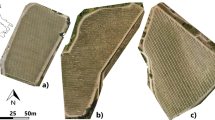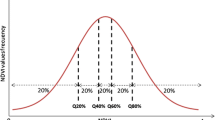Abstract
In this work we tested consistency and reliability of satellite-derived Prescription Maps (PMs) respect to those that can be obtained by aerial imagery. Test design considered a vineyard of Moscato Reale sited in Apulia (South-Eastern Italy) and two growing seasons (2013 and 2014). Comparisons concerned Landsat 8 OLI images and aerial datasets from airborne RedLake MS4100 multispectral camera. We firstly investigated the role of spatial resolution in radiometric features of data and, in particular, of NDVI maps and consequently of vigour maps. We first measured the maximum expected correlation between satellite- and aerial-derived maps. We found that, without any pixel selection and spatial interpolation, correlation ranges between 0.35 and 0.60 depending on the degree of heterogeneity of the vineyard. We also found that this result can be improved by operating a selection of those pixels representing vines canopy in aerial imagery and spatially interpolating them. In this way correlation coefficient can be improved up to 0.85 (minimum 0.60) suggesting an excellent capability of satellite data to approximate aerial ones at vineyard level. Prescription maps derived from vigour one demonstrated to be spatially consistent; but we also found that the quantitative interpretation of mapped vigour was changing in strength according to datasets and time of acquisition. Therefore, in spite of a satisfying consistency of spatial distribution, results showed that vigour strength at vineyard level from aerial and satellite datasets is generally not consistent, partially for the presence of a bias (that we modelled).








Similar content being viewed by others
References
Allen, R. G., Pereira, L. S., Raes, D., & Smith, M. (1998). Crop evapotranspiration-Guidelines for computing crop water requirements-FAO Irrigation and drainage paper 56. FAO Rome, 300(9), D05109.
Arnó, J., Bordes, X., Ribes-Dasi, M., Blanco, R., Rosell, J. R., & Esteve, J. (2005). Obtaining grape yield maps and analysis of within-field variability in Raimat (Spain). Precision Agriculture, 5, 899–906.
Bannari, A., Morin, D., Bonn, F., & Huete, A. R. (1995). A review of vegetation indices. Remote Sensing Reviews, 13(1–2), 95–120.
Bramley, R. G. V. (2001). Progress in the development of precision viticulture-variation in yield, quality and soil properties in contrasting Australian vineyards (No. 14, pp. 25–43). Occasional report. http://www.cse.csiro.au/client_serv/resources/bramley1.pdf.
Bramley, R., Pearse, B., & Chamberlain, P. (2003). Being profitable precisely-a case study of precision viticulture from Margaret River. Australian and New Zealand Grapegrower and Winemaker, 473a, 84–87.
Bramley, R. G. V., Proffitt, A. P. B., Hinze, C. J., Pearse, B., & Hamilton, R. P. (2005). Generating benefits from Precision Viticulture through selective harvesting. Precision Agriculture, 5, 891–898.
Borgogno-Mondino, E., & Lessio, A. (2015). Estimation and mapping of NDVI uncertainty from Landsat 8 OLI datasets: An operational approach. In Geoscience and Remote Sensing Symposium (IGARSS), 2015 IEEE International (pp. 629-632). http://ieeexplore.ieee.org/stamp/stamp.jsp?arnumber=7325842.
Borgogno-Mondino, E., Lessio, A., & Gomarasca, M. A. (2016). A fast operative method for NDVI uncertainty estimation and its role in vegetation analysis. European Journal of Remote Sensing, 49, 137–156.
Chappelle, E. W., Kim, M. S., & McMurtrey, J. E. (1992). Ratio analysis of reflectance spectra (RARS): an algorithm for the remote estimation of the concentrations of chlorophyll a, chlorophyll b, and carotenoids in soybean leaves. Remote Sensing of Environment, 39(3), 239–247.
Chavez, P. S. (1996). Image-based atmospheric corrections-revisited and improved. Photogrammetric Engineering and Remote Sensing, 62(9), 1025–1035.
Cook, S. E., & Bramley, R. G. V. (1998). Precision agriculture—opportunities, benefits and pitfalls of site-specific crop management in Australia. Animal Production Science, 38(7), 753–763.
Cortell, J. M., Sivertsen, H. K., Kennedy, J. A., & Heymann, H. (2008). Influence of vine vigor on Pinot noir fruit composition, wine chemical analysis, and wine sensory attributes. American Journal of Enology and Viticulture, 59(1), 1–10.
de Palma, L., Tarricone, L., Borgogno, E., Limosani, P., Paolicelli, M., & Novello, V. (2016). Fisiologia e qualità della produzione in Nero di Troia e Moscato Reale, in relazione alle differenze di vigore rilevate con tecniche di viticoltura di precisione. Acta Italus Hortus, 19, 177–178.
Delenne, C., Durrieu, S., Rabatel, G., & Deshayes, M. (2010). From pixel to vine parcel: A complete methodology for vineyard delineation and characterization using remote-sensing data. Computers and Electronics in Agriculture, 70(1), 78–83.
Dobrowski, S. Z., Ustin, S. L., & Wolpert, J. A. (2002). Remote estimation of vine canopy density in vertically shoot-positioned vineyards: Determining optimal vegetation indices. Australian Journal of Grape and Wine Research, 8(2), 117–125.
Dry, P. R. (2000). Canopy management for fruitfulness. Australian Journal of Grape and Wine Research, 6(2), 109–115.
Fenn, R. W., Clough, S. A., Gallery, W. O., Good, R. E., Kneizys, F. X., et al. (1985). Cap.18: Optical and infrared properties of the atmosphere. In A. S. Jursa (Ed.), Handbook of geophysics and space environment. Springfield, VA: NTIS.
Forgy, E. W. (1965). Cluster analysis of multivariate data: efficiency versus interpretability of classifications. Biometrics, 21, 768–769.
Forte, L., Perrino, E. V., & Terzi, M. (2005). Le praterie a Stipa austroitalica Martinovsky ssp. austroitalica dell’Alta Murgia (Puglia) e della Murgia Materana (Basilicata). Fitosociologia, 42(2), 83–103.
Frampton, W. J., Dash, J., Watmough, G., & Milton, E. J. (2013). Evaluating the capabilities of Sentinel-2 for quantitative estimation of biophysical variables in vegetation. ISPRS Journal of Photogrammetry and Remote Sensing, 82, 83–92.
Gomarasca, M. A. (2009). Basics of geomatics. New York: Springer.
Haboudane, D., Miller, J. R., Tremblay, N., Zarco-Tejada, P. J., & Dextraze, L. (2002). Integrated narrow-band vegetation indices for prediction of crop chlorophyll content for application to precision agriculture. Remote Sensing of Environment, 81(2), 416–426.
Hall, A., Lamb, D. W., Holzapfel, B., & Louis, J. (2002). Optical remote sensing applications in viticulture—A review. Australian Journal of Grape and Wine Research, 8(1), 36–47.
Hall, A., Lamb, D. W., Holzapfel, B. P., & Louis, J. P. (2011). Within-season temporal variation in correlations between vineyard canopy and winegrape composition and yield. Precision Agriculture, 12(1), 103–117.
Haselgrove, L., Botting, D., Heeswijck, R. V., Høj, P. B., Dry, P. R., et al. (2000). Canopy microclimate and berry composition: the effect of bunch exposure on the phenolic composition of Vitis vinifera L cv. Shiraz grape berries. Australian Journal of Grape and Wine Research, 6(2), 141–149.
Jackson, R. S. (2008). Wine science: Principles and applications. London: Academic Press.
Johnson, L. F., Bosch, D. F., Williams, D. C., & Lobitz, B. M. (2001). Remote sensing of vineyard management zones: Implications for wine quality. Applied Engineering in Agriculture, 17(4), 557–560.
Johnson, L. F., Roczen, D. E., Youkhana, S. K., Nemani, R. R., & Bosch, D. F. (2003). Mapping vineyard leaf area with multispectral satellite imagery. Computers and Electronics in Agriculture, 38(1), 33–44.
Johnson, L. F. (2003). Temporal stability of an NDVI-LAI relationship in a Napa Valley vineyard. Australian Journal of Grape and Wine Research, 9(2), 96–101.
King, P. D., Smart, R. E., & McClellan, D. J. (2014). Within-vineyard variability in vine vegetative growth, yield, and fruit and wine composition of Cabernet Sauvignon in Hawke’s Bay, New Zealand. Australian Journal of Grape and Wine Research, 20(2), 234–246.
Lanjeri, S., Melia, J., & Segarra, D. (2001). A multi-temporal masking classification method for vineyard monitoring in central Spain. International Journal of Remote Sensing, 22(16), 3167–3186.
Malenovský, Z., Rott, H., Cihlar, J., Schaepman, M. E., García-Santos, G., et al. (2012). Sentinels for science: Potential of Sentinel-1,-2, and-3 missions for scientific observations of ocean, cryosphere, and land. Remote Sensing of Environment, 120, 91–101.
Matese, A., Toscano, P., Di Gennaro, S. F., Genesio, L., Vaccari, F. P., et al. (2015). Intercomparison of UAV, aircraft and satellite remote sensing platforms for precision viticulture. Remote Sensing, 7(3), 2971–2990.
Montero, F. J., Melia, J., Brasa, A., Segarra, D., Cuesta, A., & Lanjeri, S. (1999). Assessment of vine development according to available water resources by using remote sensing in La Mancha, Spain. Agricultural Water Management, 40(2), 363–375.
Moran, M. S., Jackson, R. D., Slater, P. N., & Teillet, P. M. (1992). Evaluation of simplified procedures for retrieval of land surface reflectance factors from satellite sensor output. Remote Sensing of Environment, 41(2–3), 169–184.
Moran, M. S., Vidal, A., Troufleau, D., Qi, J., Clarke, T. R., et al. (1997). Combining multifrequency microwave and optical data for crop management. Remote Sensing of Environment, 61(1), 96–109.
Nagol, J. R., Vermote, E. F., & Prince, S. D. (2009). Effects of atmospheric variation on AVHRR NDVI data. Remote Sensing of Environment, 113(2), 392–397.
Petrie, P. R., Trought, M. C., & Howell, G. S. (2000). Fruit composition and ripening of Pinot Noir (Vitis vinifera L.) in relation to leaf area. Australian Journal of Grape and Wine Research, 6(1), 46–51.
Pinter, P. J., Jr., Hatfield, J. L., Schepers, J. S., Barnes, E. M., Moran, M. S., et al. (2003). Remote sensing for crop management. Photogrammetric Engineering & Remote Sensing, 69(6), 647–664.
Price, J. C., & Bausch, W. C. (1995). Leaf area index estimation from visible and near-infrared reflectance data. Remote Sensing of Environment, 52(1), 55–65.
Proffitt, T., & Proffitt, A. P. B. (2006). Precision viticulture: A new era in vineyard management and wine production (pp. 49–55). Adelaide: Winetitles.
Read, J. J., Tarpley, L., McKinion, J. M., & Reddy, K. R. (2002). Narrow-waveband reflectance ratios for remote estimation of nitrogen status in cotton. Journal of Environmental Quality, 31(5), 1442–1452.
Rey, C., Martín, M. P., Lobo, A., Luna, I., Diago, M. P., et al. (2013). Multispectral imagery acquired from a UAV to assess the spatial variability of a Tempranillo vineyard. Precision Agriculture, 13, 617–624.
Rouse, J. W., Haas, R. W., Schell, J. A., Deering, D. W., & Harlan, J. C. (1974). Monitoring the vernal advancement and retrogradation (greenwave effect) of natural vegetation. NASA/GSFCT Type III Final Report: Greenbelt, MD.
Rubin, J. (1967). Optimal classification into groups: an approach for solving the taxonomy problem. Journal of Theoretical Biology, 15(1), 103–144.
Romero, P., Gil-Muñoz, R., del Amor, F. M., Valdés, E., Fernández, J. I., & Martinez-Cutillas, A. (2013). Regulated deficit irrigation based upon optimum water status improves phenolic composition in Monastrell grapes and wines. Agricultural Water Management, 121, 85–101.
Sibanda, M., Mutanga, O., & Rouget, M. (2015). Examining the potential of Sentinel-2 MSI spectral resolution in quantifying above ground biomass across different fertilizer treatments. ISPRS Journal of Photogrammetry and Remote Sensing, 110, 55–65.
Song, J., Smart, R. E., Dambergs, R. G., Sparrow, A. M., Wells, R. B., et al. (2014). Pinot Noir wine composition from different vine vigour zones classified by remote imaging technology. Food Chemistry, 153, 52–59.
Tagarakis, A., Liakos, V., Fountas, S., Koundouras, S., & Gemtos, T. A. (2013). Management zones delineation using fuzzy clustering techniques in grapevines. Precision Agriculture, 14(1), 18–39.
Testa, S., Mondino, E. C. B., & Pedroli, C. (2014). Correcting MODIS 16-day composite NDVI time-series with actual acquisition dates. European Journal of Remote Sensing, 47, 285–305.
Thenkabail, P. S. (2003). Biophysical and yield information for precision farming from near-real-time and historical Landsat TM images. International Journal of Remote Sensing, 24(14), 2879–2904.
Winkler, A. J. (1974). General viticulture. Berkeley CA: University of California Press.
Yu, K., Lenz-Wiedemann, V., Leufen, G., Hunsche, M., Noga, G., et al. (2012). Assessing hyperspectral vegetation indices for estimating leaf chlorophyll concentration of summer barley (pp. 89–94). Remote Sensing and Spatial Information Sciences: ISPRS Annals of the Photogrammetry.
Zhang, X., Yan, G., Li, Q., Li, Z. L., Wan, H., & Guo, Z. (2006). Evaluating the fraction of vegetation cover based on NDVI spatial scale correction model. International Journal of Remote Sensing, 27(24), 5359–5372.
Web references
Earth Explorer. Free satellite multi-spectral image datasets. Accessed February 13, 2017, from http://earthexplorer.usgs.gov/.
Grass GIS. Grass GIS 6.5svn Reference Manual. Accessed February 13, 2017, from http://semiautomaticclassificationmanual.readthedocs.org/en/latest/Landsat_conversion.html.
Landsat 8 Data Users Handbook. Accessed February 13, 2017, from https://landsat.usgs.gov/sites/default/files/document/Landsat8DataUsersHandbook.pdf.
TerraSystem. Accessed February 13, 2017, from http://www.terrasystem.it/en/index.htm.
Author information
Authors and Affiliations
Corresponding author
Rights and permissions
About this article
Cite this article
Borgogno-Mondino, E., Lessio, A., Tarricone, L. et al. A comparison between multispectral aerial and satellite imagery in precision viticulture. Precision Agric 19, 195–217 (2018). https://doi.org/10.1007/s11119-017-9510-0
Published:
Issue Date:
DOI: https://doi.org/10.1007/s11119-017-9510-0




